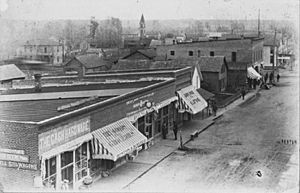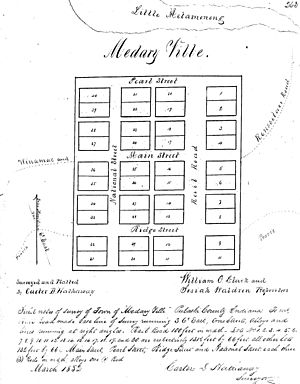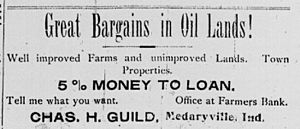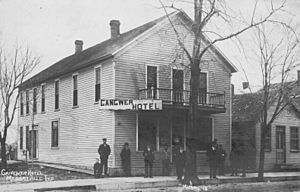Medaryville, Indiana facts for kids
Quick facts for kids
Medaryville, Indiana
|
|
|---|---|
| Nickname(s):
Tater Town, Mudville
|
|
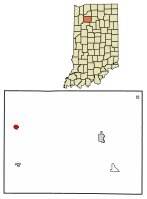
Location of Medaryville in Pulaski County, Indiana.
|
|
| Country | United States |
| State | Indiana |
| County | Pulaski |
| Township | White Post |
| Area | |
| • Total | 0.46 sq mi (1.19 km2) |
| • Land | 0.46 sq mi (1.19 km2) |
| • Water | 0.00 sq mi (0.00 km2) |
| Elevation | 689 ft (210 m) |
| Population
(2020)
|
|
| • Total | 559 |
| • Density | 1,217.86/sq mi (470.30/km2) |
| Time zone | UTC-5 (Eastern (EST)) |
| • Summer (DST) | UTC-4 (EDT) |
| ZIP code |
47957
|
| Area code(s) | 219 |
| FIPS code | 18-48186 |
| GNIS feature ID | 2396747 |
Medaryville is a small town located in Pulaski County, Indiana, in the United States. It is part of White Post Township. In 2020, the town had a population of 559 people. Medaryville is sometimes called "Tater Town" because of its history with growing potatoes.
Contents
History of Medaryville
Medaryville was founded in 1852. This happened just before the New Albany and Salem Railroad was built. This railroad was later known as the Monon Railroad. The town was placed where the new railroad crossed an old road. This road was used by settlers traveling to Winamac to record their land claims.
The railroad tracks still come into Medaryville from the south today. However, they end just north of Pearl Street. Medaryville has always been a place where farm products are shipped by train. A large complex for storing and shipping grain is still there.
Land and Environment History
Medaryville is located where two major landforms meet. The southern edge of the Grand Prairie is just south of town. To the north and west are the large, wet plains of the Greater Kankakee River basin. West of town, there used to be a huge "Impassable Swamp." Early European explorers knew about this swamp.
This swamp was drained as part of projects from the Swamp Land Act of 1850. This act led to almost all the large swamps disappearing. Before the land was drained, these wet areas had many different plants and animals. Early settlers said there was a lot of game, and many people earned a living by hunting and trapping.
Founding and Early Settlers
The first owners of the new town were Josiah Walden and William Clark. They owned the land on the east and west sides of the railroad. Carter Hathaway helped them. He was a surveyor, lawyer, and businessman.
Hathaway's detailed map of "Medary Ville" was recorded in March 1852. This happened at the Pulaski County courthouse in Winamac. The town was laid out using old English measurements. Most lots were four rods by eight rods. Streets were three rods wide, and alleys were one rod wide.
Neither Walden nor Clark stayed in Medaryville for long. They both moved further west. In 1857, Clark went to Iowa. He sold his land to William Tolbert Elston, who was the town's first doctor. Walden left for Kansas in 1864. He sold his share of the town to James C. Faris, a lawyer. Faris's son, George Washington Faris, later served in the U.S. House of Representatives.
How Medaryville Got Its Name
The town was likely named after Samuel Medary. He was a newspaper editor and politician from Ohio. He moved west with settlers and was the last governor of the Minnesota Territory. He later became the governor of the Kansas Territory. Other towns named after him include Medary, Wisconsin, and Medary, South Dakota.
The name Medary was also common in Carter Hathaway's family. He named his son Richard Medary. His brother Richard named his son Medary Montez. Carter Hathaway also helped plan Knox in 1850. He was a judge and county official in Pulaski County in the 1850s.
Oil and Potatoes
Around the year 1900, Medaryville had a small "oil rush." Many oil wells were dug west of town. A refinery was built in the nearby town of Asphaltum. However, these oil wells did not produce much oil, and the oil was not very good quality. The oil business was quickly stopped. People tried to restart the oil boom in the 1950s and 1980s, but it did not work.
Also around 1900, B. J. Gifford had a large farm project west of town. It was known as the Gifford Marsh. He also had a railroad called The Chicago and Wabash Valley. From the 1930s to about 1980, William Gehring grew vegetables on much of Gifford's old land. Because of the many potato fields nearby, Medaryville got its nickname "Tatertown." In the past, the town even held a festival called the Potato Fest to celebrate this part of its history.
Geography of Medaryville
The Jasper-Pulaski Fish and Wildlife Area is located northwest of Medaryville. This nature preserve is a very important stop for migrating Sandhill cranes. Many visitors come to see the cranes each fall. Every October, the Medaryville/White Post Township Fire Department hosts a bike ride. It is called the Crane Cruise. This ride goes through the main area where the cranes migrate.
According to the 2010 census, Medaryville covers an area of 0.46 square miles (1.19 square kilometers). All of this area is land.
Population and People
| Historical population | |||
|---|---|---|---|
| Census | Pop. | %± | |
| 1860 | 98 | — | |
| 1870 | 193 | 96.9% | |
| 1910 | 710 | — | |
| 1920 | 624 | −12.1% | |
| 1930 | 610 | −2.2% | |
| 1940 | 703 | 15.2% | |
| 1950 | 833 | 18.5% | |
| 1960 | 758 | −9.0% | |
| 1970 | 732 | −3.4% | |
| 1980 | 731 | −0.1% | |
| 1990 | 689 | −5.7% | |
| 2000 | 565 | −18.0% | |
| 2010 | 614 | 8.7% | |
| 2020 | 559 | −9.0% | |
| U.S. Decennial Census | |||
2010 Census Data
In 2010, there were 614 people living in Medaryville. There were 228 households and 163 families. The town had about 1,335 people per square mile (515 people per square kilometer). There were 274 housing units, with about 596 units per square mile (230 units per square kilometer).
Most of the people in town were White (94.8%). A small number were Native American (0.2%). Some people were from other races (3.4%), and 1.6% were from two or more races. About 6.4% of the population identified as Hispanic or Latino.
Of the 228 households, 34.6% had children under 18 living with them. About 50.9% were married couples living together. About 12.3% had a female head of household with no husband. About 8.3% had a male head of household with no wife. About 28.5% were not families.
About 24.1% of all households were single individuals. About 10.1% had someone living alone who was 65 years old or older. The average household had 2.69 people. The average family had 3.10 people.
The average age in Medaryville was 35.2 years. About 25.9% of residents were under 18 years old. About 10.2% were between 18 and 24. About 24.7% were between 25 and 44. About 24.9% were between 45 and 64. And 14.3% were 65 years or older. The town was 48.9% male and 51.1% female.
Notable People from Medaryville
- Clarence Hansell (1898–1967), a research engineer.
- Geneva Mitchell (1908–1949), an actress.
See also
 In Spanish: Medaryville (Indiana) para niños
In Spanish: Medaryville (Indiana) para niños


